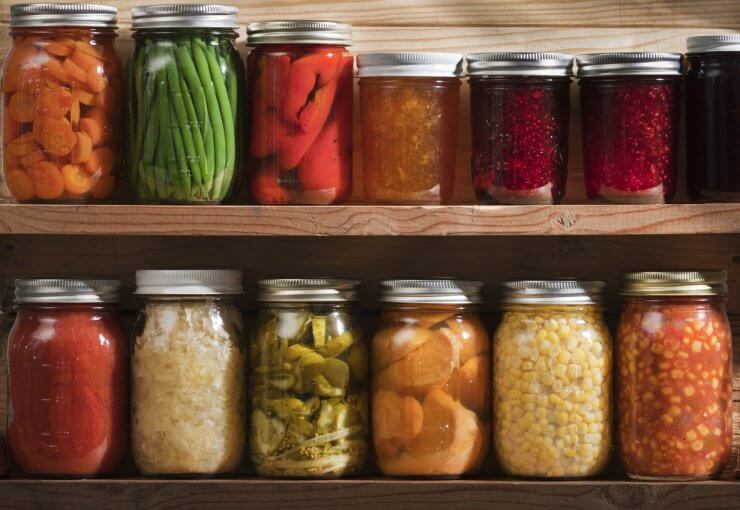
Thankfully, several simple methods can extend the life of your products while preserving as much of their nutritional value as possible.
1. Cool It
Cold storage, such as refrigeration, is ideal for certain fruits and vegetables because it slows down enzyme activity that causes ripening and spoilage. Leafy greens, broccoli, mushrooms and berries thrive in the fridge’s crisp drawer. However, not all produce belongs in the refrigerator. These foods are best kept in a cool, dark place to prevent moisture buildup and sprouting:
- Potatoes
- Onions
- Garlic
- Avocados
- Bananas
- Apricots
- Winter squash
2. Can It
Canning is an excellent method for preserving fruits and veggies, especially seasonal ones. You can store produce long after its season ends by sealing food in jars and using heat to destroy spoilage-causing microorganisms. Some canned foods can last up to five years, reducing wastage and ensuring you always have food on hand.
While canning does involve heat — which can reduce some heat-sensitive vitamins like vitamin C, it’s still a reliable way to preserve most nutrients. High-acid foods like tomatoes and fruits can be processed using a water bath method, while low-acid vegetables and beans require pressure canning for safe preservation.
3. Dehydrate or Dry It
Dehydrating or drying is a great way to turn your produce into nature’s candy. Dehydrating removes moisture from fruits and vegetables, making them less prone to spoilage while keeping most of their nutrients intact.
You can use a dehydrator, or even just your oven on low heat, and soon you’ll have crunchy, chewy snacks — minus the sugar overload.
This method slowly removes the water from the food while allowing it to retain most of its nutritional value. However, keep in mind that foods become more calorie-dense per ounce once dehydrated since they’ve lost all their water. Storing dehydrated goods in an airtight container maintains the texture and nutrients for longer.
4. Freeze It
Freezing is one of the easiest and most effective ways to preserve produce. Whether it’s berries, leafy greens, mango or peas, freezing locks in the nutrients almost immediately after harvesting.
The key to success is freezing your produce at its peak ripeness. For example, blanching vegetables like broccoli or carrots before freezing helps stop enzyme actions that could cause loss of flavor, color and texture. For fruits, flash-freezing by spreading them out on a baking sheet before transferring them to a bag keeps them from clumping together.
5. Ferment It
Fermentation isn’t just for hipsters or kombucha lovers — it’s one of the oldest, and frankly coolest, ways to preserve food. By allowing your veggies to ferment, you encourage the growth of probiotics — healthy bacteria that aid digestion.
The average adult requires 20 to 30 grams of fiber a day, and fermented foods offer an excellent way to reach this goal. Sauerkraut, kimchi and pickles are all great examples of fermented vegetables that retain their fiber. The fermentation process also boosts antioxidant activity, making this method an excellent choice for long-term nutrient preservation.
6. Pickle It
Pickling is another simple and time-tested way to preserve vegetables, using vinegar or brine to extend shelf life. This method works especially well with cucumbers, carrots, beets, onions and cabbage, but you can pickle a whole bunch of things, including:
- Watermelon rinds.
- Brussels sprouts.
- Green beans.
Pickling helps preserve the nutrients in the produce. However, it does add sodium.
7. Vacuum Seal It
Vacuum sealing is an effective technique for keeping produce fresh by removing air from storage bags to prevent oxidation. Minimizing air exposure reduces nutrient breakdown, so your produce stays fresher for longer. Pairing vacuum sealing with freezing is particularly effective for nutrient-rich vegetables like spinach or green beans.
Keep Your Produce Fresh and Nutritious
Preserving your produce is about more than just stretching its shelf life — it’s about locking in the nutrients that make fruits and veggies so valuable to your health. Whether you freeze, ferment, can or dehydrate, these methods ensure you can enjoy your favorite foods at their peak, without compromising on nutritional value.
Discover 7 top tips for growing, harvesting, and enjoying tomatoes from your home garden—when you access the FREE guide The Best Way to Grow Tomatoes, right now!




